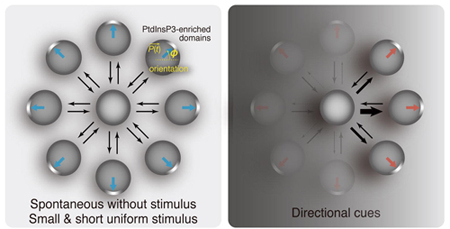
News and Announcements from the CDB
For centuries, compasses have been used as navigational instruments enabling explorers to use directional information to guide them to their destinations. Likewise, during animal development, some cells follow a compass-like mechanism that guides their movements in response to external cues in a process called chemotaxis. Chemotactic cells sense chemical gradients in the surrounding environment that induce intracellular asymmetry of the signaling pathway biased in the direction of the gradient and direct the cells either toward or away from the stimulus. However, even in the absence of external gradients, intracellular asymmetry can be produced spontaneously by the cell, a process that may be linked to random cell movements. The Laboratory for Physical Biology (Tatsuo Shibata, Unit Leader) has previously published a quantitative model of a gradient sensing system that reconstructs the phenomenon of spontaneous intracellular polarization and describes how this increases cell sensitivity and robustness, allowing them to respond to even shallow gradients.
Now, in a report published in Biophysical Journal, Masatoshi Nishikawa and colleagues in the same lab validate these models, specifically showing that excitability of the signaling pathway leads to spontaneous intracellular polarization, which can trigger both random movement in the absence of a chemoattractant gradient and biased movement in the direction of the gradient. Using the ameba, Dictyostelium discoideum, they show that the dynamics of spontaneous intracellular asymmetry is important for directional cell movement, and that this response is driven by an excitability-based mechanism.

The spatiotemporal dynamics of the phosphatidylinositol 3,4,5-triphosphate (PIP3) pathway plays an important role in chemotaxis in Dictyostelium cells, where a PIP3-enriched membrane domain is produced in response to external stimulation (cAMP) driving changes to cytoskeleton to form pseudopods used for chemotaxis. Nishikawa et al. observed that cells exhibited random spontaneous PIP3-domain formation both in absence and presence of cAMP, with this spontaneous response appearing more frequently in presence of cAMP. They also tracked and quantified the cells’ transient response levels and times when stimulated with various cAMP concentrations, and found that the average cell responses were similar, irrespective of cAMP concentration. The size of the PIP3 domain observed at peak response levels was proportional to cAMP concentration, while the overall PIP3 signal levels remained constant, suggesting that because the intensity of the responses was not influenced by the strength of the external stimulus but determined by the intracellular intrinsic activity, this is an excitable system.
If the chemotactic response is indeed driven by an excitability-based system, when the external stimulus exceeds a certain threshold to trigger a response, any responses unfolding even after the stimulus is removed can be considered to be maintained by the cell itself. When the group applied a short impulse stimulus that was shorter than the average response time, the cells showed intracellular polarization of PIP3 domains similar to one produced spontaneously, and as the length of impulses were increased, larger PIP3-domains were produced, consistent with their expectations. They also confirmed that the PIP3 signaling system has a refractory period, another indicator of an excitable system, by applying a series of successive stimuli to the cells at various time intervals.
The researchers next looked at how external gradients affected spontaneous intracellular polarization. Cells placed in conditions with a chemical gradient are known to induce localization of PIP3 in the membrane domain facing the highest cAMP concentration, driving chemotaxis in the same direction. From a theoretical perspective, spontaneous polarization of PIP3 domains, which appears in random directions in the absence of a gradient, becomes biased in the presence of an external gradient. The group found that, when presented with a gradient, the PIP3 domains appearing at random in the absence of a gradient exhibit a bias in the direction of the gradient. But, there were no significant changes in the intensity of the PIP3 response before or after the gradient was applied. These experiments demonstrate that spatial cAMP gradients orient the localization of the PIP3 domain, without changing the characteristics of the PIP3 domain.
“Our current study clearly shows that the signaling pathway for chemotaxis has excitability-based characteristics,” says Shibata. “Cells do not act only in response to external stimuli. They have a set response pattern, which, when altered slightly, produces sensitive and robust responses for diverse situations. In this study, we found that the localization of the set response pattern changes according to the gradient, which may also explain how multicellular axis and polarity formation occur. The same system may function in complex multicellular morphogenesis as well.”